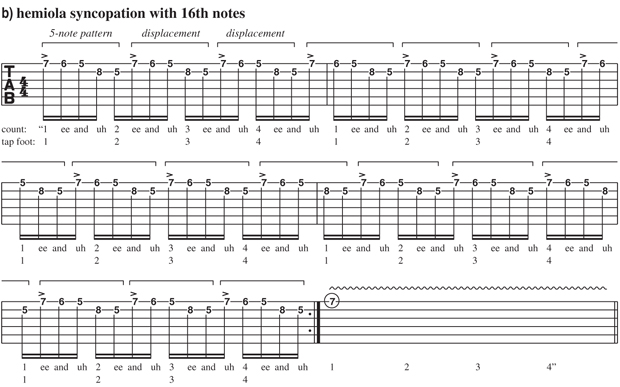Guitar 101 - Mastering Rhythm & Syncopation, Part 5: Quintuplets and Nightmare Licks

In Part 4 we covered quarter-note triplets, 16th-note triplets and sextuplets and learned how to create tricked-out hemiola licks by taking a repeating note pattern and changing its rhythm so that the pattern begins, or "pops," on a different part of the beat each time it's repeated (rhythmic displacement).
Now we're going to dive deeper into the rhythmic realm and explore a new subdivision, quintuplets-five evenly spaced notes per beat-and learn how to create psychedelic "nightmare" licks.
FIGURE 1a is a descending five-note blues scale lick played in a quintuplet rhythm (indicated by the "5" centered below the two beams connecting each five-note group). As you can see and hear, this rhythm perfectly matches the number of notes in the lick (five), so that it begins squarely on the beat each time it's repeated, producing a straightforward, unsyncopated melody. Practice playing this example a few times to get the note pattern under your fingers and help plant the quintuplet rhythm in your mind's ear. Use alternate picking (down, up, down, up, etc.) and, as always, be sure to tap your foot on each downbeat as you play.

The picking pattern can be a bit tricky because you're playing an odd number of notes-five-using an even number of picking strokes-two. Doing this makes your right hand "reverse polarity" as the first note of the lick begins on a different stroke with each repetition.
There's no standard way to count quintuplets, but I find that counting "1-bee-day-bo-dah, 2-bee-day-bo-dah, 3-bee-day-bo-dah, 4-bee-day-bo-dah, 1-bee-day-bo-dah," etc. works well because you can keep track of each quintuplet and beat without confusing the syllables with those used for triplets or 16ths.
Now let's create some musical mayhem with this same five-note pattern by changing the rhythm to throw the phrasing into a controlled tailspin. This can be done by playing the same five-note pattern as 16th notes, as shown in FIGURE 1b. As you can see and hear, the pattern begins one 16th note later each time it's repeated, creating a staggered effect as the phrasing seems to drift off and spin out of control. You'll notice, however, that there is a method to the madness, as the pattern eventually comes full circle to the point where it begins on "1" again.

A different and equally cool hemiola pattern is created by taking the same repeating five-note pattern and changing the rhythm to eighth-note triplets, as demonstrated in FIGURE 1c. Again, notice how off-kilter the phrasing sounds as the pattern seems to fall further and further out of sync with the beat on each repetition until it cycles around to the point where it lines up with the beat again (sort of like two windshield wipers moving at slightly different speeds).

Now let's see what happens when we combine hemiola-based syncopation with an already twisted-sounding "chromatic climb" lick. FIGURE 2a is an unsyncopated 16th-note run that meanders up the high E string in an "up two, back one" pattern. FIGURE 2b shows how this chromatic "rising fever" pattern can be transformed into a delirious "chromatic nightmare" lick by playing the exact same note sequence while changing the rhythm to eighth-note triplets.

Being able to play these two heavily syncopated patterns flawlessly, meaning tapping your foot while playing them repeatedly at a steady tempo without losing your count or getting into a technical "trainwreck," will take your rhythmic skills to a whole new level, as you'll be surveying every possible eighth-note-triplet and 16th-note syncopation, via accents. Proceed slowly at first and don't try playing them faster until you feel you've conquered them at slower tempos. The payoff is well worth the effort, in terms of getting great benefit from your practice time.
When creating your own "nightmare" licks, always keep in mind that it's important that you resolve them in a way that brings the listener back down to earth and punctuates the statement you've just made. If you're going to go out on a musical limb, be prepared to get back to solid ground so you don't leave your audience hanging.
Get The Pick Newsletter
All the latest guitar news, interviews, lessons, reviews, deals and more, direct to your inbox!
Over the past 30 years, Jimmy Brown has built a reputation as one of the world's finest music educators, through his work as a transcriber and Senior Music Editor for Guitar World magazine and Lessons Editor for its sister publication, Guitar Player. In addition to these roles, Jimmy is also a busy working musician, performing regularly in the greater New York City area. Jimmy earned a Bachelor of Music degree in Jazz Studies and Performance and Music Management from William Paterson University in 1989. He is also an experienced private guitar teacher and an accomplished writer.








![Joe Bonamassa [left] wears a deep blue suit and polka-dotted shirt and plays his green refin Strat; the late Irish blues legend Rory Gallagher [right] screams and inflicts some punishment on his heavily worn number one Stratocaster.](https://cdn.mos.cms.futurecdn.net/cw28h7UBcTVfTLs7p7eiLe.jpg)


